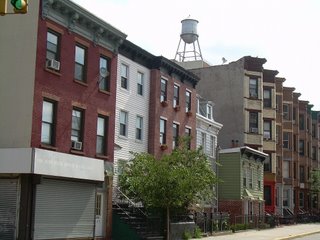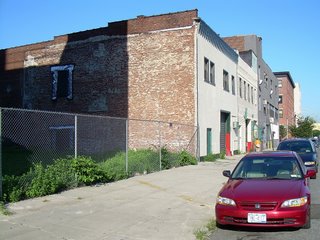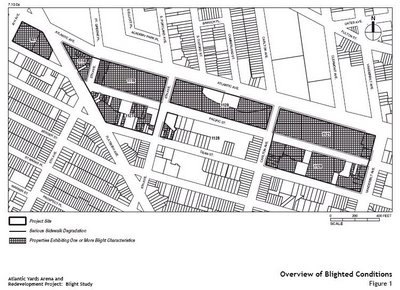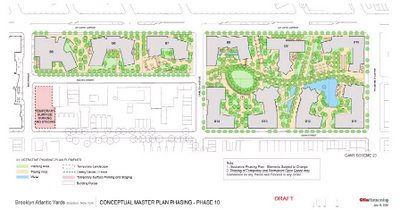 Why exactly does Forest City Ratner need a 100-foot-wide piece of land--the first five houses (right) east of Sixth Avenue on Dean Street, and counterpart property behind it on Pacific Street and Sixth Avenue, just southeast of the planned arena?
Why exactly does Forest City Ratner need a 100-foot-wide piece of land--the first five houses (right) east of Sixth Avenue on Dean Street, and counterpart property behind it on Pacific Street and Sixth Avenue, just southeast of the planned arena?According to the Empire State Development Corporation’s Blight Study, the 22-acre project area “is characterized by blighted conditions that are unlikely to be removed without public action.”
But blight is a weak argument, because those five houses, only some of which exhibit characteristics of blight, aren't much different from their neighbors, as I discuss in detail below. Rather, this rectangle of land likely has more to do with the developer's plan for staging and parking.
 There are a couple of vacant lots just around the corner on Sixth Avenue, but, as noted yesterday, there’s new construction down the block.
There are a couple of vacant lots just around the corner on Sixth Avenue, but, as noted yesterday, there’s new construction down the block.And dominating the block between Sixth and Carlton avenues is the 170-unit Newswalk luxury condo complex, converted a few years ago by developer Shaya Boymelgreen, and conspicuously omitted--likely because of the costs of buyouts or condemnation--from the Atlantic Yards plan.
(Click on all graphics to enlarge.)
Self-inflicted blight?
Given that construction, a main reason for alleged blight at the west end of the block--a vacant lot and property where development has yet to occur--may be the Atlantic Yards plan, which, after the December 2003 project announcement, froze development in the proposed footprint.
 The blight designation seems arbitrary.For example, the large grayish building in the right of the photo, at the corner of Sixth Avenue and Pacific Street, is occupied and not considered blighted.
The blight designation seems arbitrary.For example, the large grayish building in the right of the photo, at the corner of Sixth Avenue and Pacific Street, is occupied and not considered blighted.Yet it's included in the Atlantic Yards plan because it is needed to assemble the planned site.
However, the smaller buildings next to it east along Pacific Street, in the foreground, and the vacant lot further along (just before the Newswalk condos, whose water tower is visible in the top photo) are not part of the Atlantic Yards plan.
And the vacant lot, by the ESDC's definition, is blighted. Apparently, the dimensions of those lots do not fit the developer’s plan.
What are the chances?
Despite the apparent dodginess of the blight claims, a legal challenge would be tough. Courts must "give an immense amount of discretion to government bodies that make a finding of blight," Brooklyn Law School professor David Reiss said.
He added that Supreme Court's 2005 Kelo decision allows for a broad reading of the Constitution's "public use" clause, and that state courts have interpreted eminent domain broadly.
Several states, though not New York, have in the past year tightened up their eminent domain laws. According to the National Conference of State Legislatures, legislators in 27 states have passed bills regarding eminent domain.
In several cases, they have redefined blight to emphasize detriment to public health or safety; in those cases, the new laws might exclude properties--as are included in the Atlantic Yards blight study--that are economically underperforming because of vacancies or failure to build to their development potential. In other cases, they've prohibited transfers to another private owner, rather than a government entity.
 Is it relevant that the Atlantic Yards plan doesn't include some nearby parcels that are blighted under the ESDC's definition? Reiss said that wouldn't make for a legal challenge: "I don't think that you could fault an exercise of eminent domain for failing to clear all of the blight in a community."
Is it relevant that the Atlantic Yards plan doesn't include some nearby parcels that are blighted under the ESDC's definition? Reiss said that wouldn't make for a legal challenge: "I don't think that you could fault an exercise of eminent domain for failing to clear all of the blight in a community."
Arena outline?
The ESDC, in the Project Description chapter of the Draft Environmental Impact Statement, explains the process of site selection, hearkening back to a 1974 city-prepared preliminary feasibility study for a Brooklyn Sports Complex.
One of several sites considered was "the site currently being proposed for the Atlantic Yards Arena." (Above right, the outline of the Atlantic Yards plan, with designations of blight.)
But the arena site is not the project site, since 30+ years ago no developer was planning 16 towers along with the sports facility:
 In the 1974 report, the arena site extended from the corner of Flatbush and Atlantic Avenues eastward along Atlantic Avenue to Carlton Avenue. The site extended southward along Flatbush Avenue to Dean Street, continued eastward to 6th Avenue, then northward to Pacific Street and eastward to Carlton Avenue. In short, the site encompassed the arena block and Block 1120.
In the 1974 report, the arena site extended from the corner of Flatbush and Atlantic Avenues eastward along Atlantic Avenue to Carlton Avenue. The site extended southward along Flatbush Avenue to Dean Street, continued eastward to 6th Avenue, then northward to Pacific Street and eastward to Carlton Avenue. In short, the site encompassed the arena block and Block 1120.(Block 1120 is the center block of the MTA's Vanderbilt Yard. See graphic outlined in red.)
Or, in other words, it excluded the entire eastern third of the site, between Atlantic Avenue and Dean Street, and Carlton and Vanderbilt avenues. And it excluded that 100 feet of property east of Sixth Avenue between Dean and Pacific streets, as well as Site 5, at the west end below Flatbush Avenue.
Why that 100 feet?
 So why does Forest City Ratner need that 100-foot plot of land just east of Sixth Avenue? (The developer, by the way, has purchased only one of the eight properties.)
So why does Forest City Ratner need that 100-foot plot of land just east of Sixth Avenue? (The developer, by the way, has purchased only one of the eight properties.)The construction sequence planned for the project offers a hint.
The site, just across from the arena block, would be used for staging and temporary parking for years, and then be the location for the last building constructed, by 2016. In other words, the site is needed more for the construction project than to remove blight.
The Blight Study blames the railyards for blight, but also contends:
However, an equally important reason for the continued blight is that the project site has historically been held under the ownership of multiple parties, and this diversity of ownership has hindered site assemblage that is necessary for redevelopment.
Defining blight
 The Blight Study contends that 51 of the 73 parcels on the project site (70 percent) exhibit one or more blight characteristics, including: buildings or lots that exhibit signs of significant physical deterioration, buildings that are at least 50 percent vacant, lots that are built to 60 percent or less of their allowable Floor Area Ratio (FAR) under current zoning; and vacant lots. (Those lots in color are considered blighted.)
The Blight Study contends that 51 of the 73 parcels on the project site (70 percent) exhibit one or more blight characteristics, including: buildings or lots that exhibit signs of significant physical deterioration, buildings that are at least 50 percent vacant, lots that are built to 60 percent or less of their allowable Floor Area Ratio (FAR) under current zoning; and vacant lots. (Those lots in color are considered blighted.)
Note that, of the parcels on the block at issue, two small empty lots and one of the six buildings (five houses + industrial building) do not fulfill their development potential, which would be buildings, depending on the footprint, of perhaps three to six stories.
The tower that Forest City Ratner plans for the site, known as Building 15, would be 272 feet.
Sixth and Pacific
 Regarding Block 1128, the study states:
Regarding Block 1128, the study states:
The westernmost 100 feet of Block 1128 lie within the project site and are occupied by six buildings and an empty lot. At the corner of Pacific Street and 6th Avenue is a three-story, gray stuccoed warehouse building (lot 4) with wire mesh security screens covering the Pacific Street windows, and rolling metal security screens covering the building’s loading docks and entrances, many of which have graffiti.
(As noted, the two lower-rise buildings next to the three-story building at the corner are excluded, as are the adjacent vacant lot and Newswalk condos.)
It goes into detail: Lot 4 is occupied by two attached three story commercial buildings, and though the buildings have some graffiti and rusted metal grating, as well as 24 open building code violations dating from 1993 to 2004, they contain several functioning small businesses and are not considered blighted.
The houses on Dean
 The study states:
The study states:
The Dean Street portion of Block 1128 is occupied by five two- and three-story residential buildings.
As for those houses, Lot 85, the two-story building at 495 Dean and the easternmost that would be taken, is in good shape, and occupied, but because the 1200 square foot house uses less than 60 percent of the allowable square footage, it’s considered blighted.
(Then again, so would be the Atlantic Center mall.)
Lot 86, the three-story house at 493 Dean next door, is occupied and in good shape, and thus not blighted. Lot 87, the three-story house at 491 Dean in the middle of the five, uses 72 percent of the parcel’s development potential, but has 17 open building code violations issued between 1993 and 2005 and contains two vacant residential units—alleged indications of blight.
Lot 88, the second from the corner, contains a three-story house, now owned by Forest City Ratner. While the building is in good shape and uses 91 percent of its development potential, it was delivered vacant and is thus blighted, though the ground floor unit is being temporarily rented.
 Lot 89, the building at the corner of Sixth Avenue and Dean Street, is occupied by a three-story building with ground floor commercial space; it uses all of its development potential. The residential units are occupied and the commercial space is vacant, though leased.
Lot 89, the building at the corner of Sixth Avenue and Dean Street, is occupied by a three-story building with ground floor commercial space; it uses all of its development potential. The residential units are occupied and the commercial space is vacant, though leased.
While it has a cracked sidewalk and graffiti, and five five open building code violations, that doesn't rise to the level of blight. Note that the graffiti that the ESDC captured in a photo hardly rates as alarming by New York standards.
 Vacant lots
Vacant lots
The study states:
The mid-block area along 6th Avenue (lots 2 and 3) is overgrown with weeds, enclosed by a chain-link fence, and occupied by several parked cars, many of which appear to be abandoned.
(Note: the ESDC meant to identify lots 1 and 2, not 2 and 3)
 They are described as partially paved, and appear to be used for parking and to store broken down automobiles.
They are described as partially paved, and appear to be used for parking and to store broken down automobiles.
Note that a photo I took last Wednesday (left) suggests that there are fewer automobiles, with just one visible in the back right of the lot.
Lack of potential?
Not only are they vacant, but they’re not used to fulfill their development potential. Thus, they’re blighted—except that their owner is marketing them for $2.25 million. See advertisement below.
 As noted, the properties have been billed as being near but not within the Atlantic Yards project. One explanation may be that the owner is testing the market to establish a value for negotiation with the developer or the ESDC.
As noted, the properties have been billed as being near but not within the Atlantic Yards project. One explanation may be that the owner is testing the market to establish a value for negotiation with the developer or the ESDC.
A little bit blighted?
Just like there's no way to be a little bit pregnant, there's apparently no way, at least under the ESDC's definition, to be a little bit blighted.
Most of the properties exhibit few if any blight characteristics, but if they exhibit some, they're blighted. And, as noted, the most blighted properties--the empty lots--likely could be sold for a lucrative development.
Does one blight characteristic make a property blighted? It's unclear. Law professor Reiss said that he "failed to find a single reported case that discusses the statutory definition of blighted area, making me think that this is not a heavily litigated issue for those who oppose condemnations."
The statutory definition is vague. It comes in Article 18-C of the MUNICIPAL REDEVELOPMENT LAW, section 970-C:)
a) "Blighted area" means an area within a municipality in which one or more of the following conditions exist: (i) a predominance of buildings and structures which are deteriorated or unfit or unsafe for use or occupancy; or (ii) a predominance of economically unproductive lands, buildings or structures, the redevelopment of which is needed to prevent further deterioration which would jeopardize the economic well being of the people.
This raises a question: do "economically unproductive" properties by definition require redevelopment? If not, what's the test to examine whether "further deterioration" would jeopardize the public well-being?
Blight chart for Block 1128
(Remember, FAR = Floor Area Ratio, or the measure of square footage allowed for the plot.)
| Significant physical deterioration | At least 50% vacant | Lots at <60> | Vacant lots | ||
| Lot 1 | MAYBE | YES | YES | YES | BLIGHTED |
| Lot 2 | MAYBE | YES | YES | YES | BLIGHTED |
| Lot 4 | NO | NO | NO | NO | NOT BLIGHTED |
| Lot 85 | NO | NO | YES | NO | BLIGHTED |
| Lot 86 | NO | NO | NO | NO | NOT BLIGHTED |
| Lot 87 | NO | YES | NO | NO | BLIGHTED |
| Lot 88 | NO | YES | NO | NO | BLIGHTED |
| Lot 89 | NO | NO | NO | NO | NOT BLIGHTED |
What next?
The New York State Bar Association's Special Task Force on Eminent Domain issued a report in March, recommending, among other things, that the 30-day statute of limitations for judicial review of eminent domain determinations should be expanded, since it gives property owners too little time to respond. While the task force recommended that eminent domain not be restricted to certain public projects, it called for a temporary state commission to examine eminent domain.
Could it be that state law gets reformed after the Atlantic Yards project moves forward?
Comments
Post a Comment